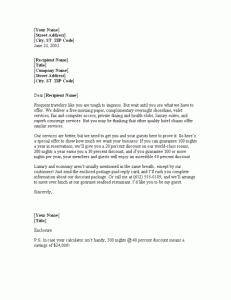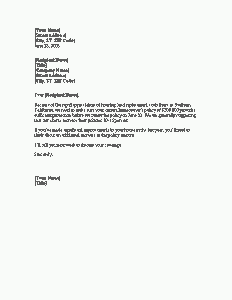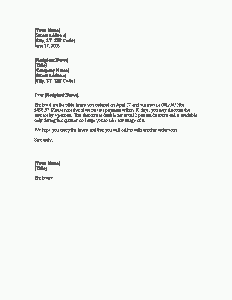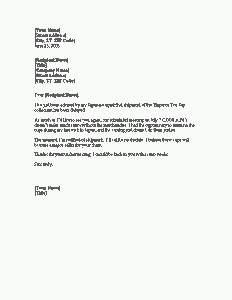Enhance Efficiency and Productivity with Our Premium Equipment: 29-Sample Sales Letters
Welcome to our Equipment Maintenance and Care section, where we provide valuable insights and resources to help you keep your equipment in optimal condition. We understand that proper maintenance plays a crucial role in maximizing the performance, longevity, and reliability of your equipment. Whether you’re a seasoned equipment owner or new to maintenance tasks, this dedicated section is designed to guide you through routine maintenance tasks, offer troubleshooting tips, share best practices, and provide comprehensive resources for your convenience. By following our expert advice and recommendations, you can ensure that your equipment operates at its best, minimizing downtime and maximizing your investment. Explore our wide range of maintenance topics, from cleaning methods to storage guidelines, and gain the knowledge and confidence to maintain your equipment with ease.
#1: Introduction Letter:
This letter introduces your equipment company, providing an overview of your offerings and establishing a connection with potential customers.
An introduction letter for an equipment company serves as a way to connect with potential customers and provide them with an overview of the company’s offerings. It is designed to showcase the company’s expertise, highlight the quality and reliability of its equipment, and create awareness among potential customers. The purpose of the introduction letter is to establish a connection, generate interest, and lay the groundwork for building strong and lasting relationships with potential customers.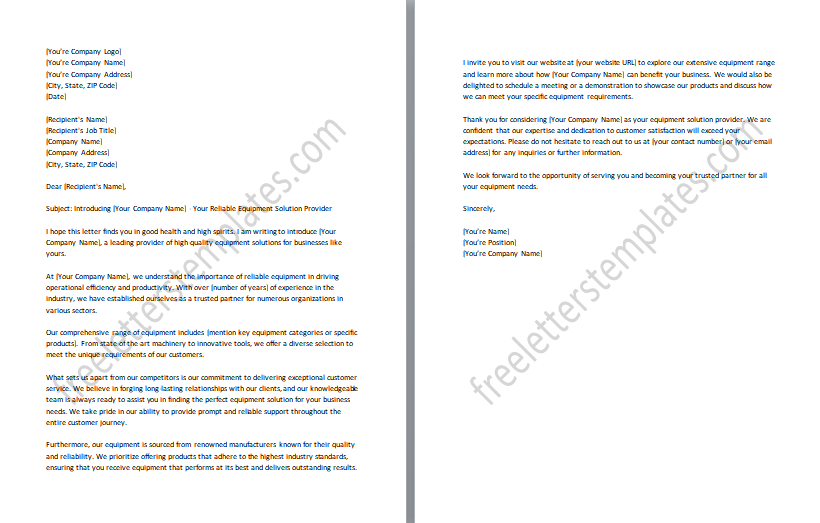
#2: Product Showcase Letter:
It focuses on highlighting specific equipment products, emphasizing their features and benefits to generate interest.
A product showcase letter is a powerful tool used by equipment companies to highlight specific equipment products and generate interest among potential customers. This type of letter focuses on showcasing the unique features, benefits, and advantages of the equipment offerings. By emphasizing the key selling points and demonstrating how the equipment can meet the specific needs of customers, the product showcase letter aims to create excitement and generate curiosity. It serves as an opportunity for the company to showcase its expertise, build credibility, and entice potential customers to explore the showcased products further.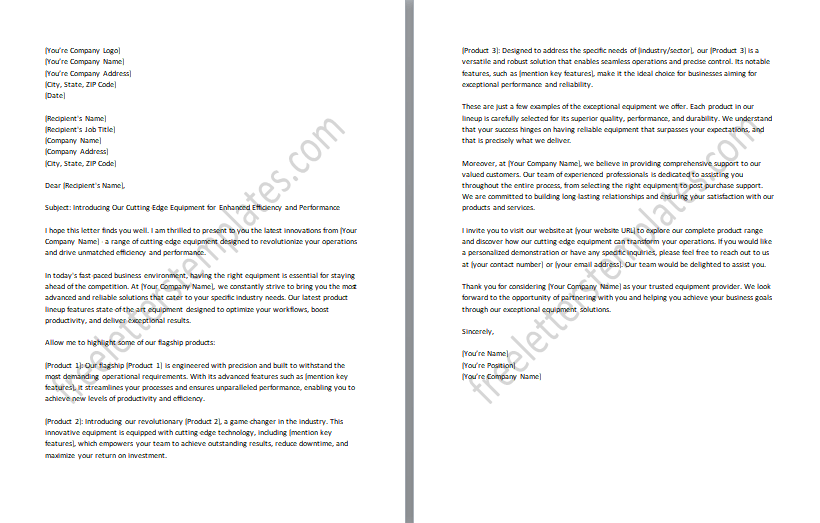
#3: Exclusive Discount Letter:
This letter offers special discounts on equipment purchases to create a sense of exclusivity and urgency.
An exclusive discount letter is a strategic communication tool used by equipment companies to offer special discounts on equipment purchases. The primary objective of this letter is to create a sense of exclusivity and urgency among potential customers. By providing limited-time offers or exclusive discounts, the company aims to make customers feel valued and privileged. This type of letter often highlights the savings and benefits customers can enjoy by taking advantage of the exclusive discount. The sense of urgency created by the limited-time nature of the offer encourages customers to act quickly and make a purchase. Ultimately, the exclusive discount letter serves as a persuasive incentive for potential customers to choose the company’s equipment over competitors and drive sales.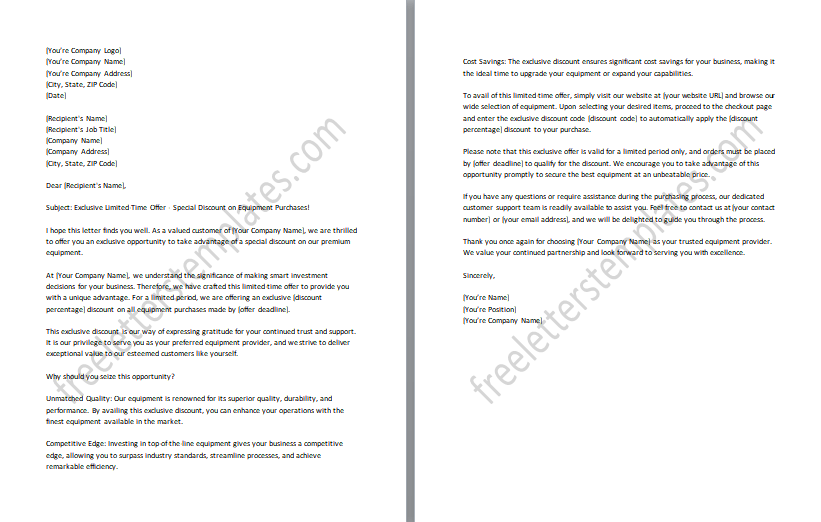
#4: Limited-Time Offer Letter:
It promotes a time-limited sale of equipment, creating a sense of urgency for customers to take advantage of the offer.
A limited-time offer letter is a compelling marketing tool used by equipment companies to promote time-limited sales of their products. The primary purpose of this letter is to create a sense of urgency and encourage customers to take immediate action. By highlighting the limited duration of the offer, the company aims to motivate potential customers to make a purchase decision sooner rather than later. This type of letter typically emphasizes the significant discounts or special incentives available during the limited-time sale, making it an attractive opportunity for customers to save money or gain additional benefits. The limited-time offer letter effectively grabs the attention of customers, prompts them to act quickly, and ultimately drives sales for the equipment company.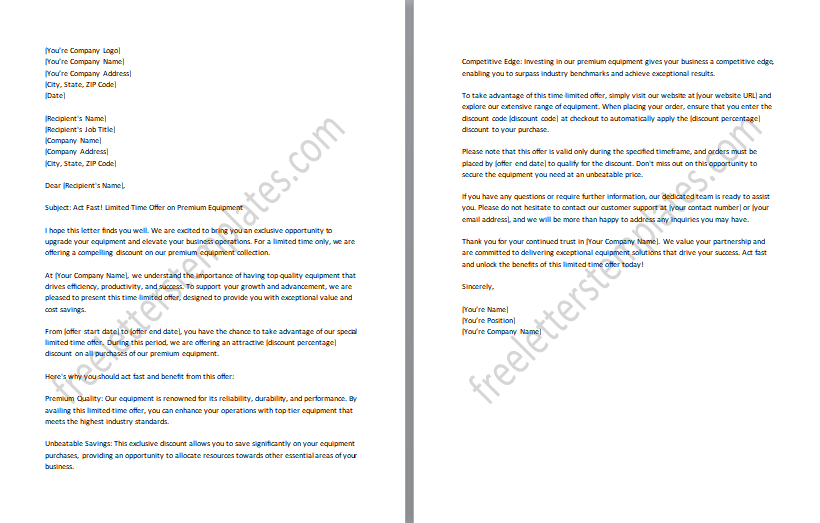
#5: New Product Launch Letter:
This letter announces the introduction of a new equipment product line, generating excitement and interest among customers.
A new product launch letter is an exciting announcement used by equipment companies to introduce a new product line to their customers. The primary objective of this letter is to generate excitement, curiosity, and interest among customers. It serves as a platform to showcase the innovative features, unique benefits, and cutting-edge technology of the new equipment product line. The letter aims to create a buzz and build anticipation by highlighting how the new products can address customer needs more effectively or offer enhanced functionality compared to previous offerings. By effectively communicating the value proposition and competitive advantages of the new product line, the company can capture the attention of existing and potential customers, encouraging them to explore and consider these exciting new equipment options.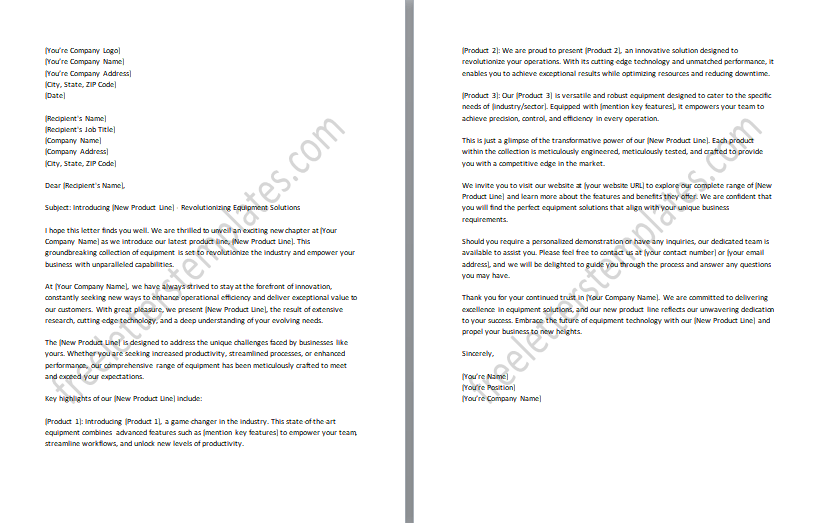
#6: Upgrade Promotion Letter:
It encourages customers to upgrade their existing equipment by highlighting the advantages and benefits of newer models.
An upgrade promotion letter is a persuasive communication tool used by equipment companies to encourage customers to upgrade their existing equipment to newer models. The main objective of this letter is to highlight the advantages and benefits of upgrading, thereby motivating customers to consider investing in the latest equipment offerings. The letter emphasizes how the newer models offer improved features, enhanced performance, increased efficiency, or additional functionalities compared to the customer’s current equipment. By effectively communicating the value proposition and demonstrating how the upgrade can positively impact the customer’s operations or productivity, the company aims to generate interest and encourage customers to take action. The upgrade promotion letter serves as a catalyst for customers to explore the benefits of upgrading their equipment and ultimately drive sales for the company.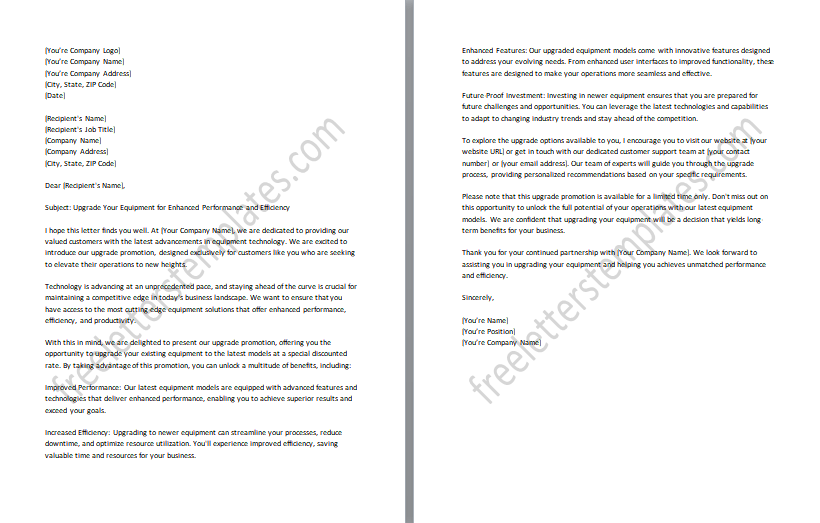
#7: Maintenance and Support Package Letter:
This letter offers equipment maintenance and support services to provide customers with peace of mind.
A maintenance and support package letter is a valuable communication tool used by equipment companies to offer customers comprehensive maintenance and support services for their equipment. The primary objective of this letter is to provide customers with peace of mind by highlighting the benefits and advantages of opting for a maintenance and support package. The letter emphasizes how the package ensures the long-term performance, reliability, and durability of the equipment. It may outline the range of services included in the package, such as regular inspections, preventive maintenance, timely repairs, and dedicated customer support. By showcasing the company’s commitment to customer satisfaction and the value of proactive maintenance, the letter aims to build trust and encourage customers to invest in the maintenance and support package. Ultimately, the maintenance and support package letter demonstrates the company’s dedication to providing exceptional service and ensuring the ongoing success of the customer’s equipment operations.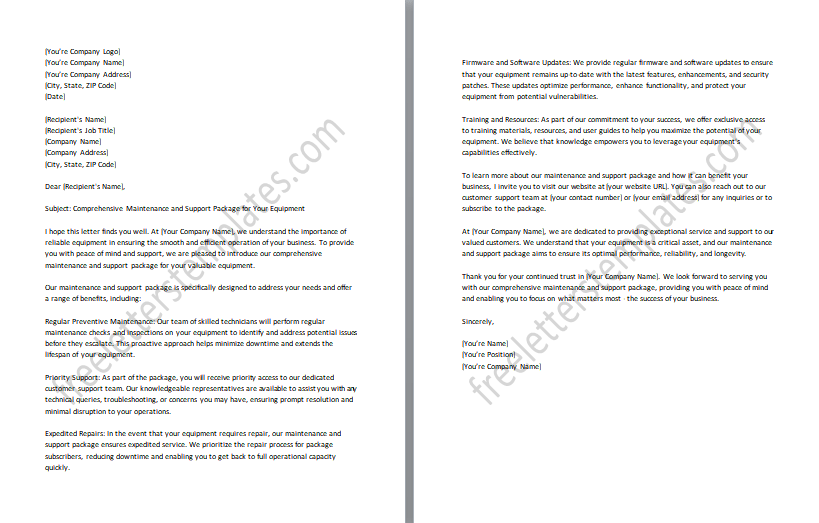
#8: Bulk Purchase Letter:
It provides incentives for customers to make bulk equipment orders, such as volume discounts or special pricing.
A bulk purchase letter is a compelling communication tool used by equipment companies to encourage customers to make large-scale orders of their products. The primary objective of this letter is to provide incentives that entice customers to consider bulk purchases, such as volume discounts or special pricing. The letter emphasizes the advantages and benefits of bulk purchasing, including cost savings, economies of scale, and streamlined procurement processes. It may outline the specific discounts or pricing structures available for bulk orders, as well as any additional perks such as priority shipping or personalized customer service. By showcasing the value proposition of bulk purchasing, the company aims to attract customers who have a higher demand or need for larger quantities of equipment. The bulk purchase letter serves as a persuasive tool to build stronger customer relationships, increase sales volume, and establish the company as a preferred supplier for bulk equipment needs.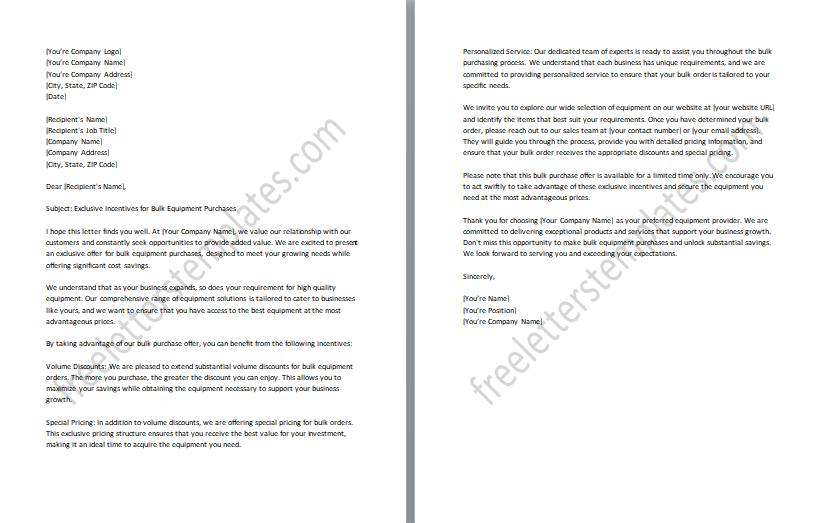
#9: Lease-to-Own Option Letter:
This letter presents equipment leasing options with the possibility of ownership, appealing to customers who prefer a flexible payment approach.
A lease-to-own option letter is an enticing communication tool used by equipment companies to present customers with flexible payment alternatives for acquiring equipment. The main objective of this letter is to highlight the benefits of equipment leasing with the potential for ownership. The letter emphasizes how the lease-to-own option provides customers with the opportunity to use the equipment immediately while spreading out the cost over manageable lease payments. It may outline the key advantages, such as lower upfront costs, tax benefits, and the ability to upgrade or purchase the equipment at the end of the lease term. By showcasing the flexibility and financial advantages of the lease-to-own option, the company aims to appeal to customers who prefer a more budget-friendly and adaptable approach to acquiring equipment. The lease-to-own option letter serves as a persuasive tool to attract customers and facilitate their access to the equipment they need, without the burden of a significant upfront investment.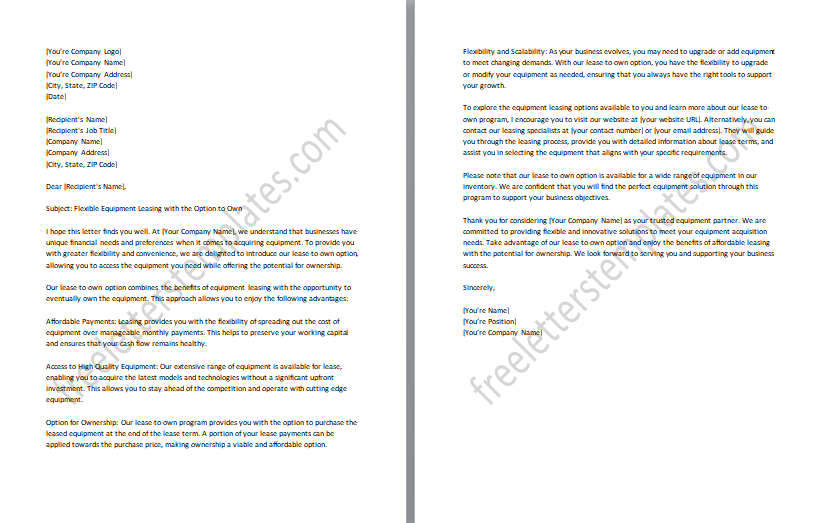
#10: Customization Services Letter:
It emphasizes your equipment company’s ability to customize products to meet specific customer needs and preferences.
A customization services letter is a powerful communication tool used by equipment companies to highlight their expertise in tailoring products to meet specific customer needs and preferences. The main objective of this letter is to emphasize the company’s ability to provide customized solutions that align with the unique requirements of customers. The letter showcases how the equipment company can modify or personalize its products to enhance functionality, optimize performance, or incorporate specific features based on individual customer preferences. It may outline the process of customization, the range of options available, and the benefits of choosing customized equipment over off-the-shelf alternatives. By showcasing its customization capabilities, the company aims to position itself as a trusted partner that can address customers’ unique challenges and provide them with precisely tailored solutions. The customization services letter serves as a persuasive tool to differentiate the company from competitors and attract customers who value tailored solutions that align perfectly with their specific needs.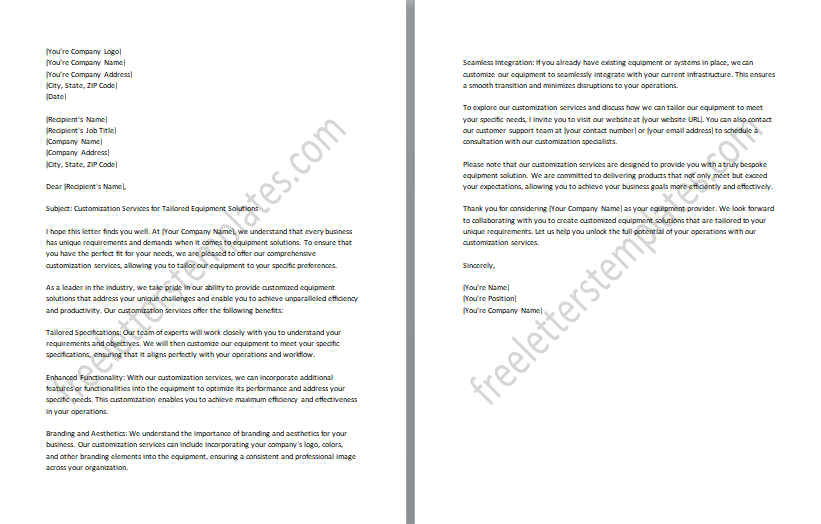
#11: Warranty Extension Letter:
This letter offers customers the opportunity to extend the warranty on their equipment, enhancing their confidence in the product. A warranty extension letter is a valuable communication tool used by equipment companies to offer customers the option to extend the warranty on their equipment. The primary objective of this letter is to enhance customers’ confidence in the product and provide them with added peace of mind. The letter highlights the benefits of extending the warranty, such as prolonged protection against defects or malfunctions beyond the standard warranty period. It may outline the terms and conditions of the warranty extension, including the cost, duration, and scope of coverage. By presenting the opportunity to extend the warranty, the company aims to demonstrate its commitment to customer satisfaction and the quality of its products. The warranty extension letter serves as a proactive measure to build stronger customer relationships, instill trust in the equipment’s reliability, and encourage customers to invest in the extended warranty for enhanced protection and long-term peace of mind.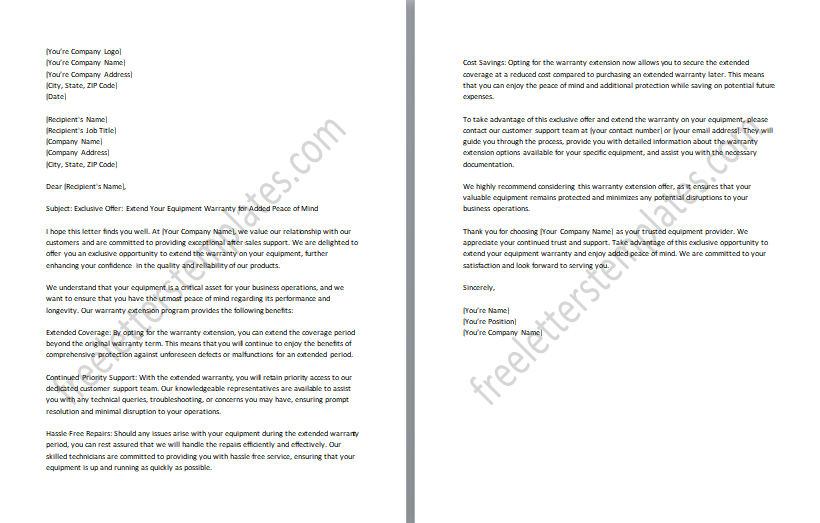
#12: Trade-In Program Letter:
It promotes a trade-in program where customers can exchange their old equipment for new models, incentivizing repeat purchases.
A trade-in program letter is a compelling communication tool used by equipment companies to promote a trade-in program that allows customers to exchange their old equipment for newer models. The primary objective of this letter is to incentivize repeat purchases by offering customers a convenient and cost-effective way to upgrade their equipment. The letter emphasizes the benefits of the trade-in program, such as the opportunity to receive a value or credit for their old equipment, which can be applied towards the purchase of a new model. It may outline the process of the trade-in program, including evaluation, pricing, and the seamless transition to the upgraded equipment. By showcasing the advantages of participating in the trade-in program, the company aims to encourage customers to take advantage of this opportunity to upgrade their equipment while offsetting the cost. The trade-in program letter serves as a persuasive tool to foster customer loyalty, drive repeat purchases, and ensure that customers have access to the latest and most advanced equipment models.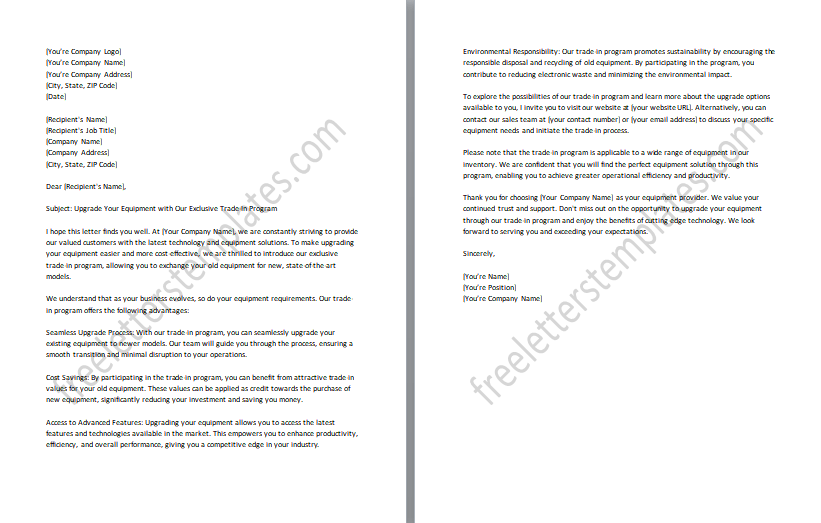
#13: Referral Incentive Letter:
This letter encourages customers to refer others to your equipment company by offering incentives or rewards for successful referrals.
A referral incentive letter is an effective communication tool used by equipment companies to encourage customers to refer others to their business. The main objective of this letter is to harness the power of word-of-mouth marketing and leverage existing customer relationships to expand the customer base. The letter emphasizes the benefits of referring friends, colleagues, or business associates to the equipment company. It may outline the referral incentives or rewards that customers can earn for successful referrals, such as discounts, credits, or exclusive offers. By highlighting the value of customer referrals and expressing gratitude for their support, the company aims to motivate customers to actively promote their products and services. The referral incentive letter serves as a proactive strategy to increase brand awareness, attract new customers through trusted recommendations, and reward loyal customers for their advocacy and support.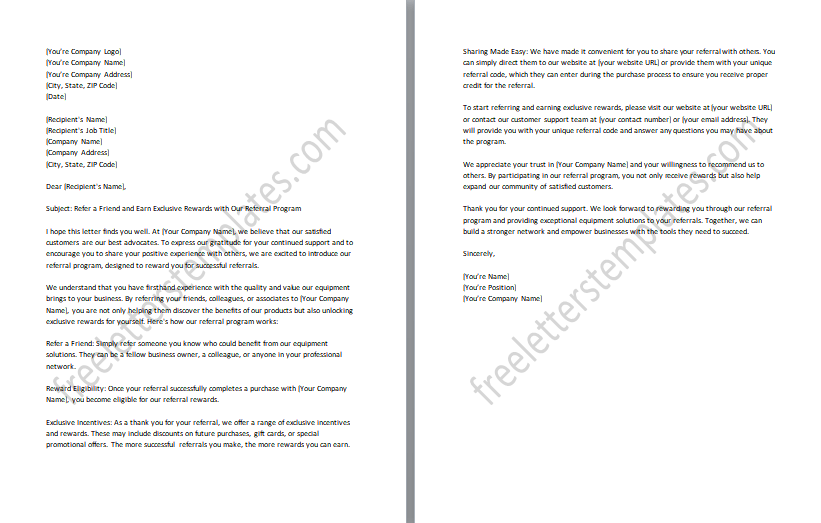
#14: Seasonal Sale Letter:
It promotes seasonal discounts on equipment, aligning your offerings with specific occasions or seasons.
A seasonal sale letter is an effective communication tool used by equipment companies to promote special discounts and offers that are aligned with specific occasions or seasons. The primary objective of this letter is to create a sense of excitement and urgency among customers by highlighting the limited-time seasonal promotions. The letter emphasizes the benefits of taking advantage of seasonal sales, such as significant cost savings, exclusive deals, or bundled packages. It may outline the specific equipment products that are part of the seasonal sale and provide details on the discounted prices or promotional offers. By aligning its offerings with popular occasions or seasons, the company aims to capture the attention of customers who are actively seeking equipment or are looking to make the most of the seasonal promotions. The seasonal sale letter serves as a persuasive tool to drive customer engagement, boost sales during specific periods, and create a sense of urgency for customers to make their purchases before the season or occasion ends.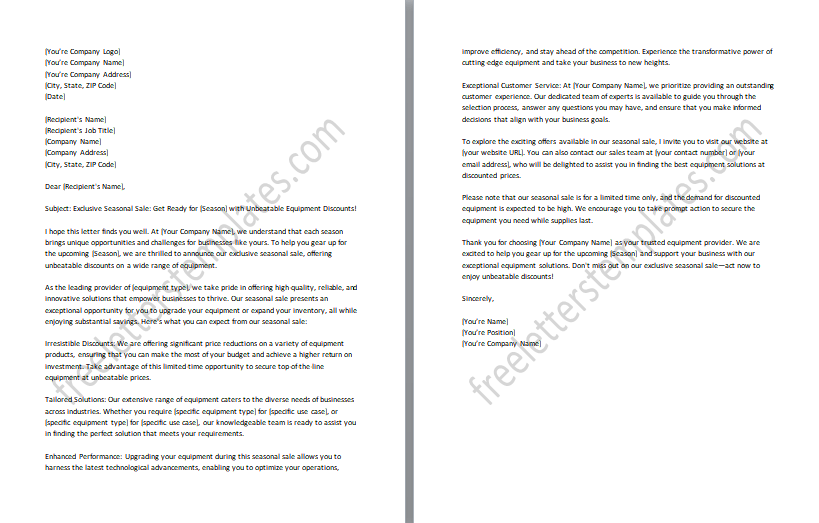
#15: Financing Options Letter:
This letter presents equipment financing solutions, making it easier for customers to afford their desired equipment.
A financing options letter is a valuable communication tool used by equipment companies to present customers with convenient and accessible financing solutions for their equipment purchases. The primary objective of this letter is to make it easier for customers to afford the equipment they desire by offering flexible payment plans. The letter highlights the benefits of financing options, such as spreading out the cost over time, preserving cash flow, and avoiding large upfront payments. It may outline the specific financing plans available, including low-interest rates, deferred payment options, or customized repayment schedules. By showcasing the availability of financing solutions, the company aims to remove financial barriers and enable customers to acquire the equipment they need without straining their budget. The financing options letter serves as a persuasive tool to attract customers who may have budget constraints or prefer the convenience of installment payments, ultimately increasing sales and customer satisfaction by providing accessible financing alternatives.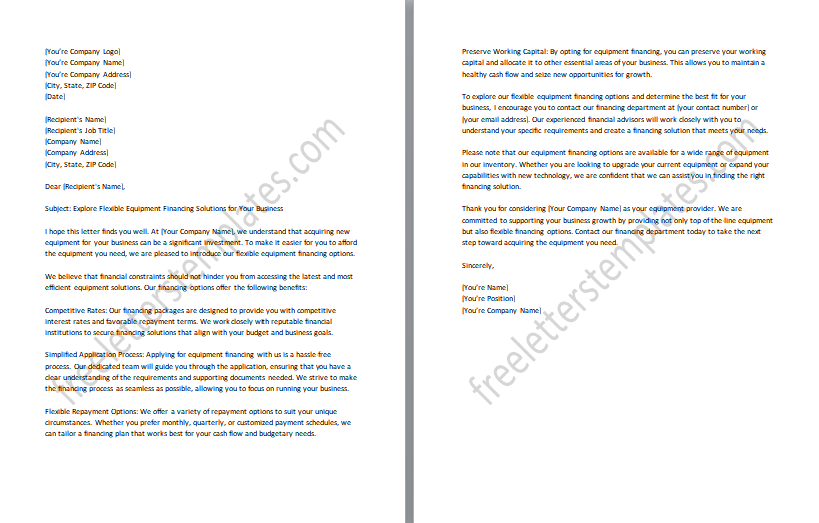
#16: Customer Testimonial Letter:
It shares positive experiences and testimonials from satisfied customers, building trust and credibility for your equipment. A customer testimonial letter is a powerful communication tool used by equipment companies to share positive experiences and testimonials from satisfied customers. The primary objective of this letter is to build trust and credibility by showcasing real-life examples of customers who have benefited from using the company’s equipment. The letter highlights the positive feedback, success stories, and specific benefits that customers have experienced with the equipment. It may include quotes, anecdotes, or case studies that illustrate how the equipment has solved their challenges, improved efficiency, or positively impacted their business operations. By sharing these testimonials, the company aims to demonstrate the reliability, performance, and value of its equipment, providing potential customers with reassurance and confidence in their purchasing decision. The customer testimonial letter serves as a persuasive tool to influence prospective customers by leveraging the positive experiences and recommendations of existing satisfied customers, ultimately strengthening the company’s reputation and encouraging new business.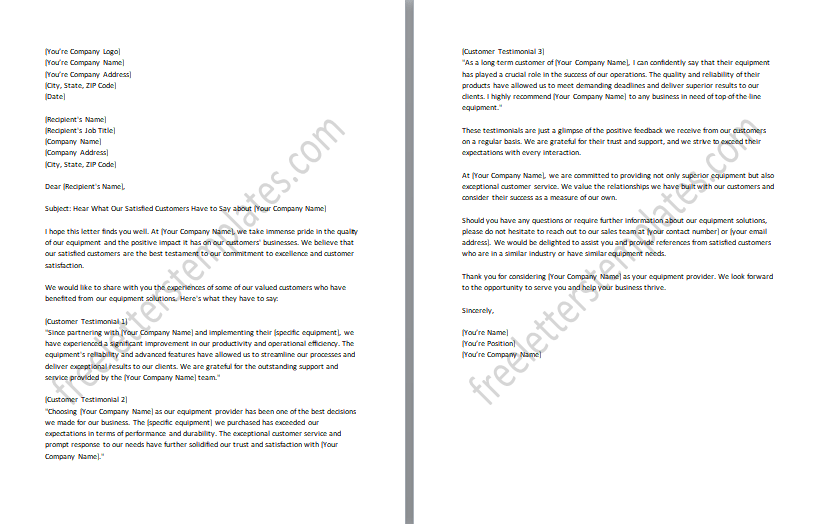
#17: Industry-Specific Equipment Solutions Letter:
It addresses the unique needs and requirements of specific industries, showcasing how your equipment caters to their specific challenges. An industry-specific equipment solutions letter is a targeted communication tool used by equipment companies to address the unique needs and requirements of specific industries. The main objective of this letter is to showcase how the company’s equipment is tailored to cater to the specific challenges and demands of the industry in question. The letter emphasizes the deep understanding of the industry and highlights how the equipment solutions provided by the company address industry-specific pain points, enhance productivity or streamline operations. It may include examples, case studies, or testimonials from customers within the industry to demonstrate the effectiveness of the equipment in solving industry-specific challenges. By addressing the unique needs of the industry, the company aims to position itself as a trusted partner with specialized expertise, offering tailored solutions that align perfectly with the industry’s requirements. The industry-specific equipment solutions letter serves as a persuasive tool to attract customers within a specific industry, build credibility, and establish the company as a go-to provider for industry-specific equipment solutions.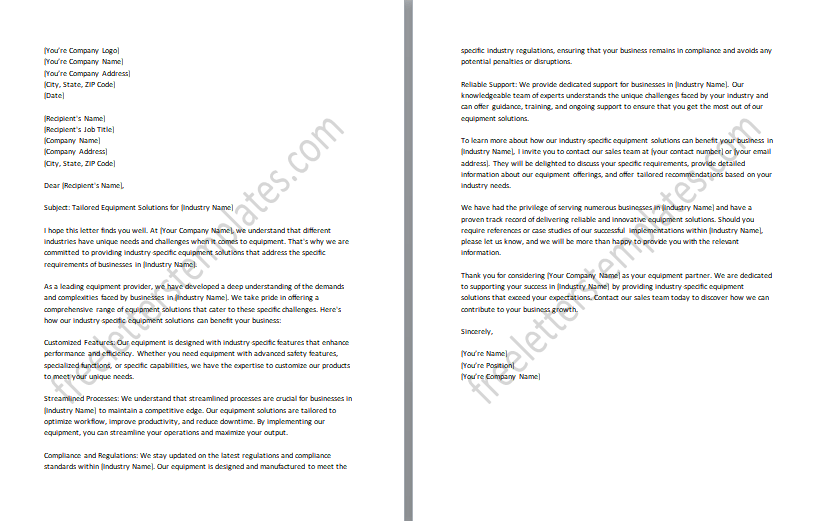
#18: Energy-Efficient Equipment Letter:
This letter highlights the energy-saving features and benefits of your equipment, appealing to environmentally conscious customers.
An energy-efficient equipment letter is a compelling communication tool used by equipment companies to highlight the energy-saving features and benefits of their products. The primary objective of this letter is to appeal to environmentally conscious customers by showcasing how the company’s equipment contributes to energy conservation and sustainability. The letter emphasizes the energy-saving technologies, certifications, or design features incorporated into the equipment, such as energy-efficient motors, smart controls, or low-power consumption. It may outline the specific environmental benefits, such as reduced carbon emissions or lower utility costs, that customers can enjoy by choosing energy-efficient equipment. By promoting the energy-saving aspects of its products, the company aims to attract customers who prioritize environmental responsibility and want to make a positive impact on the planet. The energy-efficient equipment letter serves as a persuasive tool to demonstrate the company’s commitment to sustainability, encourage eco-friendly purchasing choices, and differentiate its products as environmentally conscious options in the market.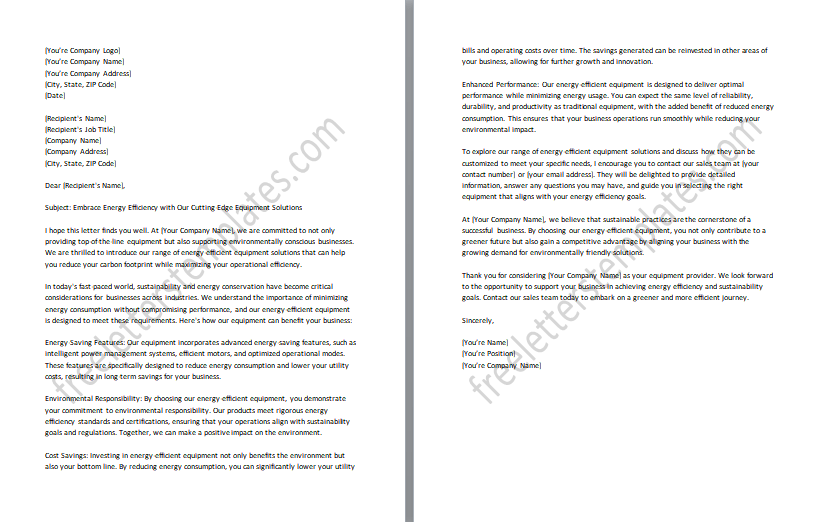
#19: Demonstration Invitation Letter:
It invites prospects to experience equipment demonstrations or showcases, giving them hands-on exposure to your products.
A demonstration invitation letter is an engaging communication tool used by equipment companies to invite prospects to experience equipment demonstrations or showcases. The primary objective of this letter is to provide prospects with a hands-on opportunity to see and interact with the company’s products. The letter extends a warm invitation to attend a scheduled demonstration event or visit a showroom where the equipment will be showcased. It highlights the benefits of attending the demonstration, such as gaining a deeper understanding of the equipment’s features, functionalities, and performance. It may outline the agenda for the demonstration, including live demonstrations, interactive sessions, or expert presentations. By extending the invitation, the company aims to create a personalized and immersive experience for prospects, allowing them to witness the value and capabilities of the equipment firsthand. The demonstration invitation letter serves as a persuasive tool to engage prospects, build excitement, and encourage them to take the next step in their purchasing journey by attending the demonstration event or visiting the showroom.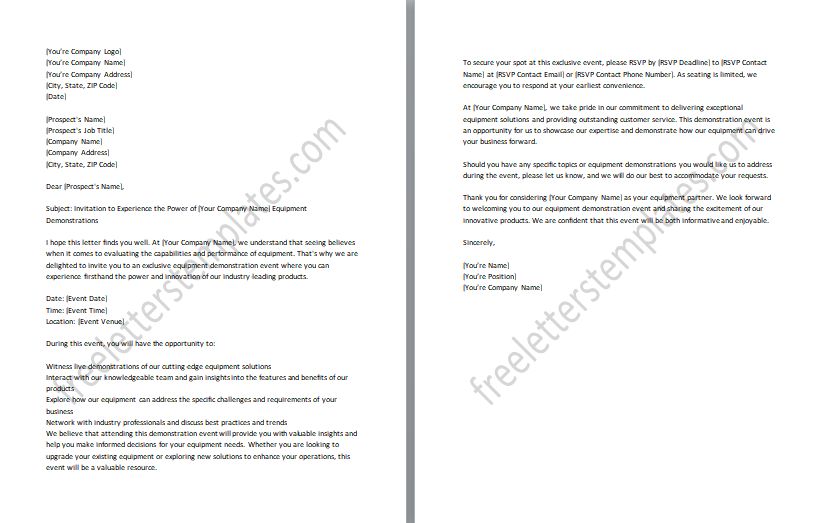
#20: Equipment Rental Services Letter:
This letter promotes your equipment rental services, catering to customers with temporary or short-term equipment needs. An equipment rental services letter is an effective communication tool used by equipment companies to promote their equipment rental services. The main objective of this letter is to cater to customers with temporary or short-term equipment needs by offering them a convenient and cost-effective rental solution. The letter highlights the benefits of equipment rental, such as flexibility, affordability, and access to a wide range of equipment options. It may outline the types of equipment available for rent, the rental terms and conditions, and any additional services or support provided along with the rental. By promoting its equipment rental services, the company aims to attract customers who require equipment for specific projects, events, or temporary needs without the commitment of purchasing and maintaining the equipment long-term. The equipment rental services letter serves as a persuasive tool to showcase the advantages of renting equipment from the company, providing customers with a hassle-free and cost-efficient solution that meets their temporary equipment needs.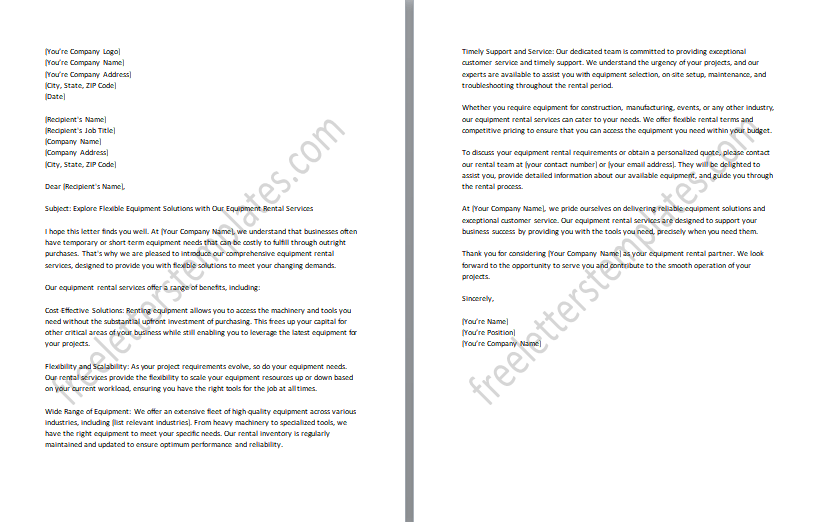
#21: Training and Education Letter:
It offers equipment training and educational resources to support customers in maximizing the value of their purchases.
A training and education letter is an informative communication tool used by equipment companies to offer training and educational resources to customers. The primary objective of this letter is to support customers in maximizing the value of their equipment purchases by providing them with the necessary knowledge and skills. The letter highlights the training programs, workshops, webinars, or educational materials available to customers. It may outline the topics covered, the format of the training (in-person or online), and any certifications or qualifications that customers can achieve through the training. By offering training and educational resources, the company aims to empower customers to effectively and efficiently use the equipment, troubleshoot common issues, and unlock its full potential. The training and education letter serves as a proactive approach to customer support, demonstrating the company’s commitment to customer success and long-term satisfaction. It encourages customers to take advantage of the training opportunities available, enabling them to optimize their equipment usage, enhance productivity, and achieve their desired outcomes.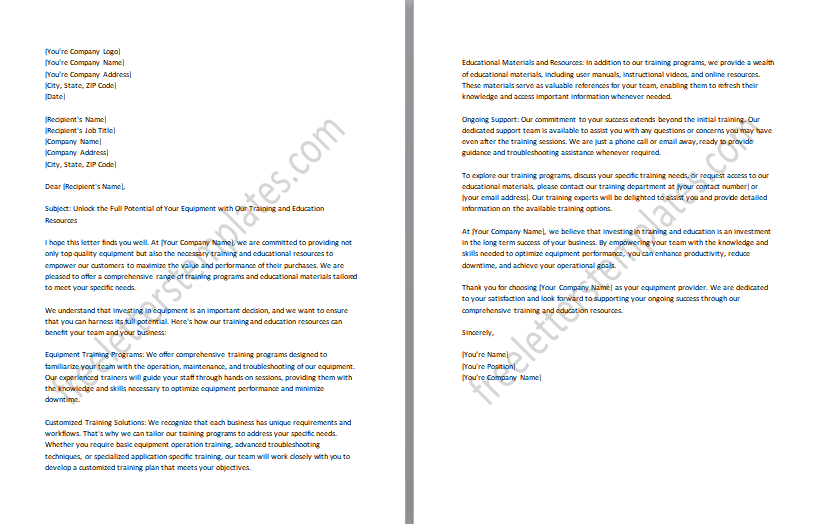
#22: Upcoming Trade Show Letter:
This letter invites customers to visit your equipment booth at a trade show, providing an opportunity to engage directly with your team and products.
An upcoming trade show letter is an inviting communication tool used by equipment companies to inform customers about their participation in an upcoming trade show and to invite them to visit their booth. The main objective of this letter is to create awareness and generate interest in the trade show event, offering customers the opportunity to engage directly with the company’s team and products. The letter provides key details about the trade show, such as the event dates, location, and the company’s booth number. It highlights the benefits of attending the trade show, such as the chance to explore the latest equipment offerings, witness live demonstrations, and interact with knowledgeable staff members. By extending the invitation, the company aims to foster personal connections with customers, answer their questions, and showcase the unique features and benefits of their equipment in person. The upcoming trade show letter serves as a persuasive tool to encourage customers to mark their calendars and make plans to visit the company’s booth, facilitating face-to-face interactions, networking opportunities, and potential business collaborations.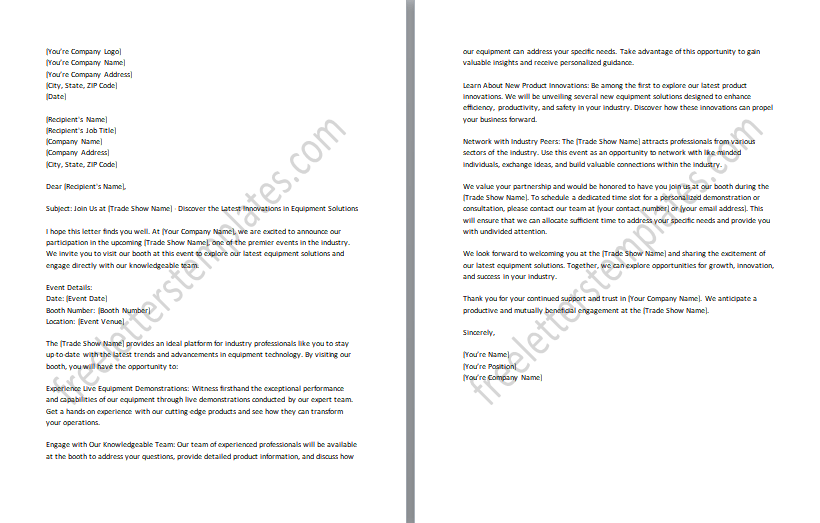
#23: Partnerships and Collaboration Letter:
It explores potential collaboration opportunities with other businesses or organizations, expanding your reach and customer base. A partnership and collaboration letter is a proactive communication tool used by equipment companies to explore potential collaboration opportunities with other businesses or organizations. The main objective of this letter is to expand the company’s reach and customer base by establishing strategic partnerships and fostering mutually beneficial relationships. The letter introduces the company and its offerings, highlighting key strengths and value propositions. It expresses the company’s interest in exploring collaborative opportunities and outlines the potential benefits that can arise from such partnerships, such as expanded market reach, access to new customer segments, shared resources, or synergistic capabilities. The letter may suggest specific areas of collaboration, such as co-marketing initiatives, joint projects, or complementary product offerings. By reaching out to potential partners, the company aims to leverage the strengths and expertise of both parties to create a win-win situation that drives growth and enhances the overall value delivered to customers. The partnerships and collaboration letter serves as an invitation to explore possibilities, initiate conversations, and lay the foundation for fruitful partnerships that can mutually contribute to the success of all parties involved.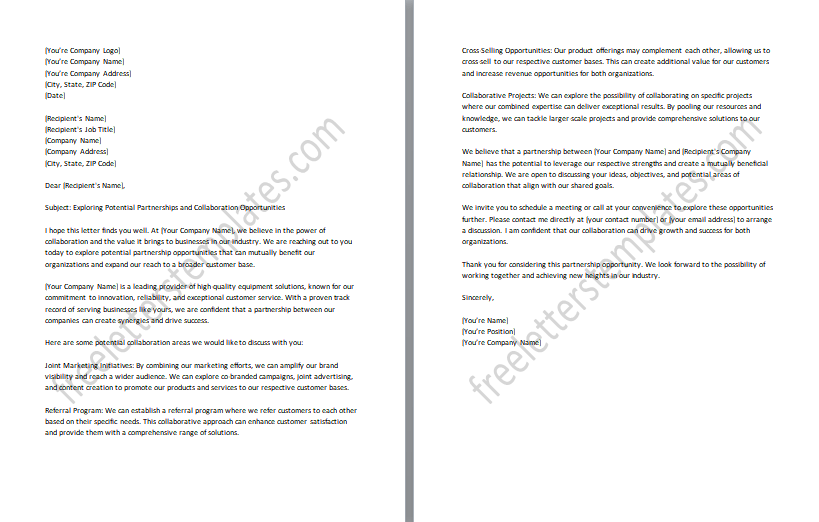
#24: Equipment Maintenance Tips Letter:
This letter provides maintenance tips and best practices to help customers ensure the longevity and optimal performance of their equipment. An equipment maintenance tips letter is an informative communication tool used by equipment companies to provide valuable maintenance tips and best practices to customers. The main objective of this letter is to assist customers in ensuring the longevity and optimal performance of their equipment by offering guidance on proper maintenance techniques. The letter shares practical tips and recommendations related to equipment upkeep, including cleaning procedures, regular inspections, lubrication guidelines, storage recommendations, and any specific maintenance tasks that are critical for the equipment’s functionality. It may also highlight the importance of following the manufacturer’s guidelines and scheduling routine maintenance checks. By providing maintenance tips, the company aims to empower customers to take proactive measures in caring for their equipment, reducing the risk of breakdowns, improving equipment lifespan, and minimizing costly repairs. The equipment maintenance tips letter serves as a valuable resource that demonstrates the company’s commitment to customer success and satisfaction. It encourages customers to adopt good maintenance practices, enabling them to optimize equipment performance, enhance safety, and maximize their return on investment.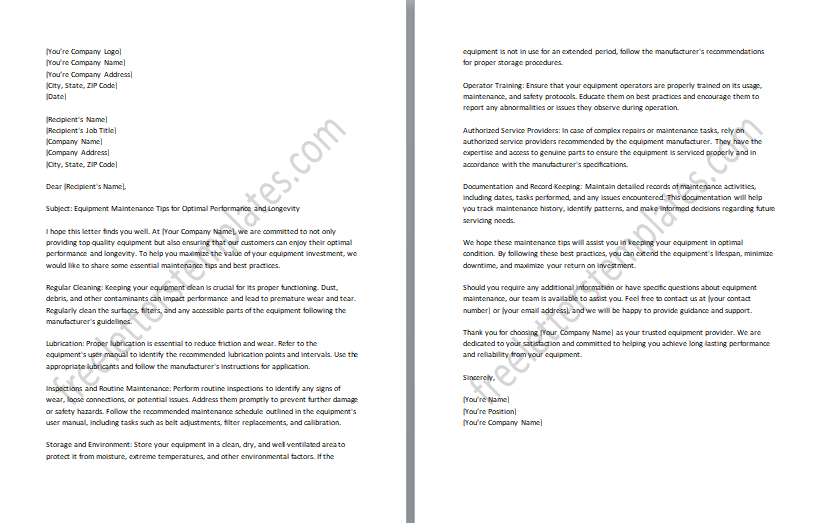
#25: Safety and Compliance Letter:
It highlights the safety features and compliance standards of your equipment, addressing customers’ concerns and regulatory requirements.
A safety and compliance letter is an important communication tool used by equipment companies to address customers’ concerns regarding safety and regulatory requirements. The main objective of this letter is to highlight the safety features and compliance standards of the company’s equipment, reassuring customers that their well-being and adherence to regulations are top priorities. The letter provides detailed information about the safety features integrated into the equipment, such as protective guards, emergency stop buttons, or safety interlocks. It also emphasizes compliance with industry-specific regulations, certifications, or standards that the equipment meets, ensuring that customers can confidently use the equipment in accordance with legal requirements. Additionally, the letter may outline any safety training or educational resources offered by the company to support customers in using the equipment safely. By addressing safety and compliance concerns, the company aims to build trust, mitigate risks, and instill confidence in customers that their equipment purchases align with the highest safety standards. The safety and compliance letter serves as a testament to the company’s commitment to providing reliable and safe equipment solutions, promoting a culture of safety and regulatory compliance within the industry.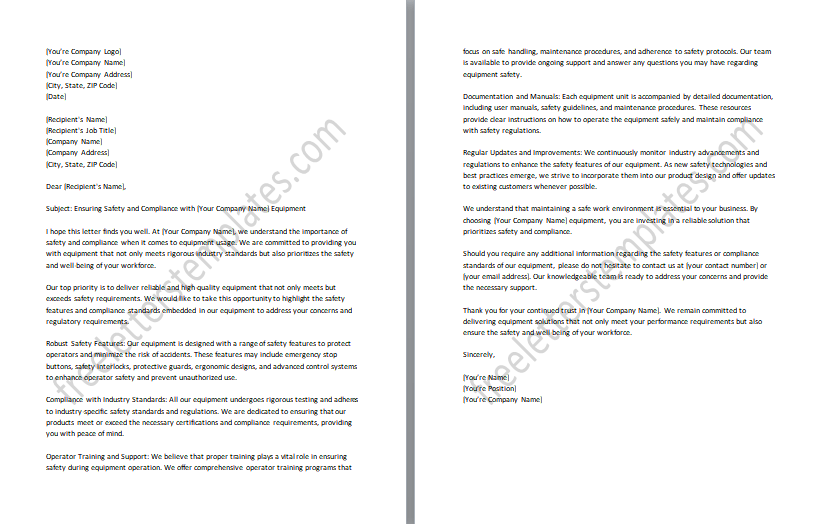
#26: After-Sales Support Letter:
This letter assures customers of ongoing support and assistance after their purchase, reinforcing your commitment to their satisfaction. An after-sales support letter is a reassuring communication tool used by equipment companies to emphasize their commitment to providing ongoing support and assistance to customers after their purchase. The main objective of this letter is to reinforce the company’s dedication to customer satisfaction and to assure customers that they can rely on the company for any post-purchase needs or concerns. The letter acknowledges the customer’s recent purchase and expresses gratitude for their trust in the company’s products. It then highlights the various avenues of support available to the customer, such as a dedicated customer service hotline, email support, or online resources. It may also mention any warranty or service agreement that comes with the equipment, detailing the coverage and duration. Additionally, the letter may mention the company’s commitment to timely response and resolution of any customer inquiries or issues. By providing after-sales support, the company aims to foster long-term customer relationships, enhance the overall ownership experience, and build trust and loyalty. The after-sales support letter serves as a reminder to customers that they are valued and that the company stands ready to assist them throughout their equipment ownership journey.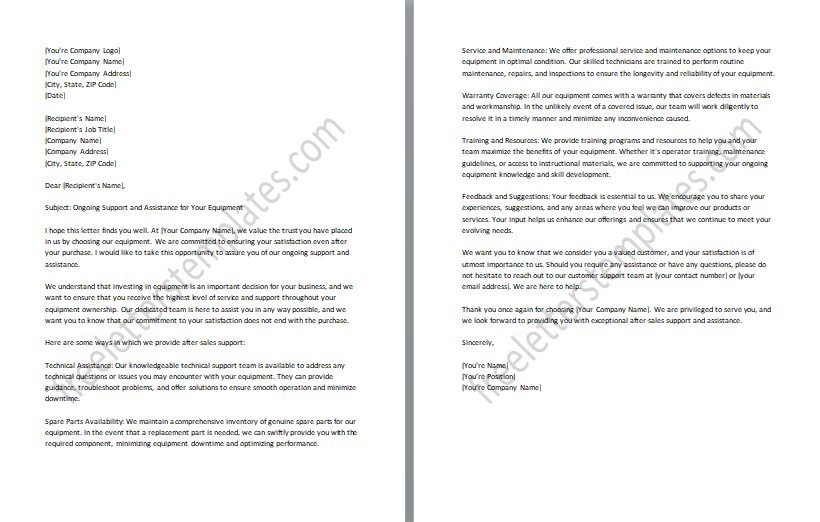
#27: Loyalty Rewards Program Letter:
It presents a rewards program for repeat equipment purchases, encouraging customer loyalty and repeat business. A loyalty rewards program letter is an enticing communication tool used by equipment companies to introduce and promote a rewards program aimed at encouraging customer loyalty and repeat business. The main objective of this letter is to showcase the benefits and perks of the loyalty rewards program, motivating customers to continue choosing the company for their equipment needs. The letter begins by expressing appreciation for the customer’s past purchases and loyalty. It then outlines the key features of the rewards program, such as exclusive discounts, special promotions, or personalized offers reserved for program members. The letter may also explain the mechanics of the program, including how customers can earn points or rewards, track their progress, and redeem their rewards. It emphasizes the value that loyal customers will receive by being part of the program, such as access to new product launches, priority service, or VIP experiences. By offering a loyalty rewards program, the company aims to strengthen customer relationships, foster repeat business, and create a sense of exclusivity and appreciation. The loyalty rewards program letter serves as an invitation for customers to engage further with the company, rewarding their loyalty and incentivizing continued support and partnership.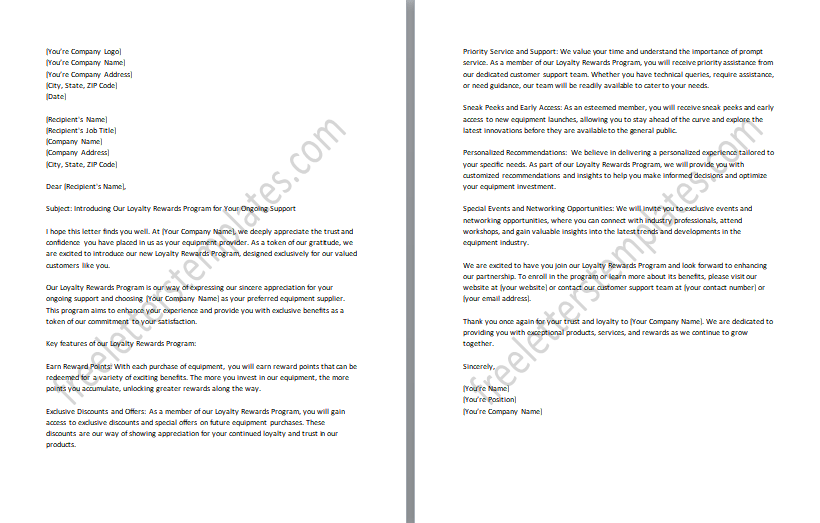
#28: Case Study Letter:
This letter shares success stories and case studies of businesses that have benefited from using your equipment, demonstrating its value and impact.
A case study letter is a compelling communication tool used by equipment companies to share success stories and real-life examples of businesses that have experienced significant benefits from using their equipment. The main objective of this letter is to showcase the value and impact of the equipment by presenting concrete evidence of its effectiveness in solving specific challenges and delivering positive outcomes. The letter begins by introducing the case study and highlighting the industry or business sector in which the success story takes place. It then outlines the challenges faced by the business and explains how the company’s equipment provided a solution to those challenges. The letter goes on to describe the specific benefits and results achieved by the business as a direct result of using the equipment, such as increased productivity, cost savings, improved efficiency, or enhanced safety. It may include quantitative data, testimonials from key individuals within the business, or before-and-after comparisons to further substantiate the success story. By sharing case studies, the company aims to demonstrate the practical value and tangible benefits that customers can expect when utilizing their equipment. The case study letter serves as a powerful tool to build credibility, inspire confidence, and help potential customers make informed decisions by showcasing real-world examples of the equipment’s impact.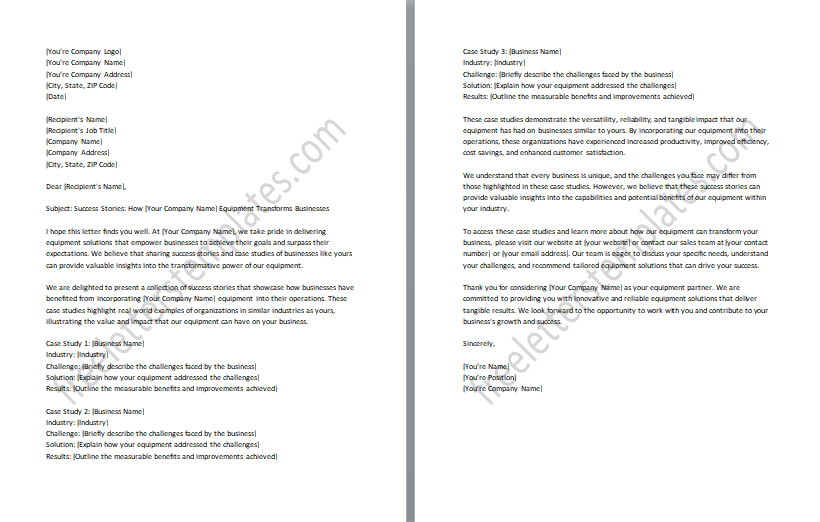
#29: Equipment Upgrades and Add-ons Letter:
It offers upgrades and add-ons to enhance the functionality and performance of customers’ existing equipment, providing options for improvement.
The equipment upgrades and add-ons letter is a concise communication tool that informs customers about available enhancements for their existing equipment. It highlights the benefits and improvements that can be achieved by incorporating upgrades and add-ons, such as increased efficiency, expanded functionality, or enhanced safety features. The letter assures customers of compatibility with their current equipment and provides details on the installation process and pricing. By offering these options, the company aims to help customers optimize their equipment’s performance and stay up-to-date with industry advancements, providing them with valuable options for improvement and customization.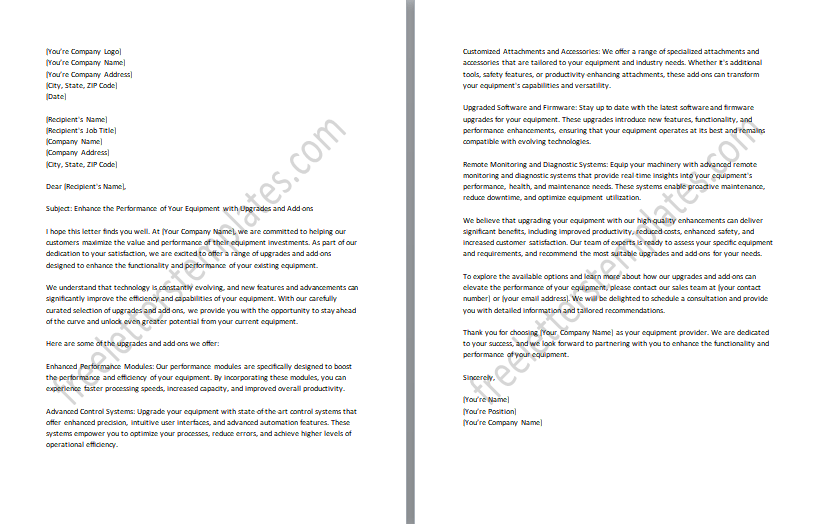
Equipment Maintenance and Care: Keeping Your Equipment in Optimal Condition
- Routine Maintenance Tasks: Provide a list of essential maintenance tasks that should be performed regularly to keep the equipment in optimal condition. This may include tasks such as cleaning, lubrication, calibration, or inspections. Explain why each task is important and the recommended frequency for performing them.
- Troubleshooting Common Issues: Offer troubleshooting tips for common issues or problems that customers may encounter with the equipment. Provide step-by-step instructions or a troubleshooting guide to help users identify and resolve issues on their own. Include potential causes, recommended solutions, and any precautions to take.
- Best Practices: Share best practices for operating and handling the equipment to ensure its longevity and performance. This may include guidelines on proper usage, storage recommendations, safety precautions, and environmental considerations. Offer insights on how to optimize the equipment’s capabilities and avoid potential pitfalls.
- Inspection Checklist: Provide a comprehensive checklist that users can follow to conduct thorough equipment inspections. Include key areas to inspect, such as electrical connections, moving parts, fluid levels, filters, and any specific components relevant to your equipment.
- Recommended Cleaning Methods: Outline proper cleaning techniques for different parts of the equipment, including recommended cleaning agents, tools, and safety precautions. Emphasize the importance of regular cleaning to prevent dirt, debris, or residue buildup that can impact performance.
- Storage Guidelines: Offer guidelines for proper equipment storage when not in use, including temperature and humidity recommendations, protective covers or cases, and considerations for long-term storage. Help users understand how to safeguard the equipment from environmental factors that may lead to damage or degradation.
- Maintenance Schedule: Provide a suggested maintenance schedule that users can follow based on the manufacturer’s recommendations. This can include periodic servicing, component replacements, and calibration intervals. Encourage users to keep records of maintenance activities for future reference.
- Safety Precautions: Highlight important safety precautions that users should take while performing maintenance tasks. This may include wearing protective gear, disconnecting power sources, following lockout/tagout procedures, and other safety measures specific to your equipment.
- Training Resources: Recommend training programs or resources that can help users gain a deeper understanding of equipment maintenance and troubleshooting. This can include online tutorials, user manuals, video guides, or even on-site training options.
- FAQ Section: Compile a list of frequently asked questions related to equipment maintenance and provide concise answers to address common concerns or queries. This can help users find quick solutions or clarifications on maintenance-related topics.
Enhancing Brand Presence and Generating Interest with Sales Letters
In conclusion, a well-crafted sales letter is vital for an equipment company to promote its products and attract customers. By utilizing various types of sales letters, such as introductions, product showcases, exclusive discounts, and more, the company can effectively communicate its value, highlight product features, and address customer needs. These letters serve as strategic communication tools that capture attention, generate interest, and convert prospects into satisfied customers. With careful planning and persuasive language, sales letters can drive sales, build relationships, and establish a strong brand presence.
← Previous Article
« Cultivating Donor Relationships: The Art of Crafting 25-Meaningful Thank You LettersNext Article →
36 Cover Letter Templates for All Kinds of Jobs and Industries »